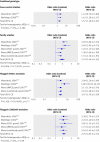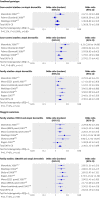Filaggrin gene defects and risk of developing allergic sensitisation and allergic disorders: systematic review and meta-analysis
- PMID: 19589816
- PMCID: PMC2714678
- DOI: 10.1136/bmj.b2433
Filaggrin gene defects and risk of developing allergic sensitisation and allergic disorders: systematic review and meta-analysis
Abstract
Objective: To investigate whether filaggrin gene defects, present in up to one in 10 western Europeans and North Americans, increase the risk of developing allergic sensitisation and allergic disorders.
Design: Systematic review and meta-analysis.
Data sources: Medline, Embase, ISI Science Citation Index, BIOSIS, ISI Web of Knowledge, UK National Research Register, clinical trials.gov, the Index to Theses and Digital dissertations, and grey literature using OpenSIGLE.
Study selection: Genetic epidemiological studies (family, case-control) of the association between filaggrin gene defects and allergic sensitisation or allergic disorders.
Data extraction: Atopic eczema or dermatitis, food allergy, asthma, allergic rhinitis, and anaphylaxis, along with relevant immunological variables relating to the risk of allergic sensitisation as assessed by either positive skin prick testing or increased levels of allergen specific IgE.
Data synthesis: 24 studies were included. The odds of developing allergic sensitisation was 1.91 (95% confidence interval 1.44 to 2.54) in the family studies and 1.57 (1.20 to 2.07) in the case-control studies. The odds of developing atopic eczema was 1.99 (1.72 to 2.31) in the family studies and 4.78 (3.31 to 6.92) in the case-control studies. Three studies investigated the association between filaggrin gene mutations and allergic rhinitis in people without atopic eczema: overall odds ratio 1.78 (1.16 to 2.73). The four studies that investigated the association between filaggrin gene mutations and allergic rhinitis in people with atopic eczema reported a significant association: pooled odds ratio from case-control studies 2.84 (2.08 to 3.88). An overall odds ratio for the association between filaggrin gene mutations and asthma in people with atopic eczema was 2.79 (1.77 to 4.41) in case-control studies and 2.30 (1.66 to 3.18) in family studies. None of the studies that investigated filaggrin gene mutations and asthma in people without atopic eczema reported a significant association; overall odds ratio was 1.30 (0.7 to 2.30) in the case-control studies. The funnel plots suggested that publication bias was unlikely to be an explanation for these findings. No studies investigated the association between filaggrin gene mutations and food allergy or anaphylaxis.
Conclusions: Filaggrin gene defects increase the risk of developing allergic sensitisation, atopic eczema, and allergic rhinitis. Evidence of the relation between filaggrin gene mutations and atopic eczema was strong, with people manifesting increased severity and persistence of disease. Filaggrin gene mutations also increased the risk of asthma in people with atopic eczema. Restoring skin barrier function in filaggrin deficient people in early life may help prevent the development of sensitisation and halt the development and progression of allergic disease.
Conflict of interest statement
Competing interests: None declared.
Figures






Comment in
-
Gene defects and allergy.BMJ. 2009 Jul 9;339:b1203. doi: 10.1136/bmj.b1203. BMJ. 2009. PMID: 19589814 No abstract available.
References
-
- Parham P. The immune system. 2nd ed. London: Garland Science Publishing, 2005.
-
- Gupta R, Sheikh A, Strachan DP, Anderson HR. Burden of allergic disease in the UK: secondary analyses of national databases. Clin Exp Allergy 2004;34:520-6. - PubMed
-
- Strachan DP, Sheikh A. A life course approach to respiratory and allergic diseases. In: Kuh D, Ben-Shlomo Y, eds. A life course approach to chronic disease epidemiology. 2nd ed. Oxford: Oxford University Press, 2004.
Publication types
MeSH terms
Substances
LinkOut - more resources
Full Text Sources
Medical
